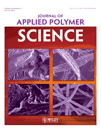Mechanical properties of natural fiber hybrid composites based on renewable thermoset resins derived from soybean oil, for use in technical applications
Abstract
Natural fiber composites are known to have lower mechanical properties than glass or carbon fiber reinforced composites. The hybrid natural fiber composites prepared in this study have relatively good mechanical properties. Different combinations of woven and non-woven flax fibers were used. The stacking sequence of the fibers was in different orientations, such as 0°, +45°, and 90°. The composites manufactured had good mechanical properties. A tensile strength of about 119 MPa and Young's modulus of about 14 GPa was achieved, with flexural strength and modulus of about 201 MPa and 24 GPa, respectively. For the purposes of comparison, composites were made with a combination of woven fabrics and glass fibers. One ply of a glass fiber mat was sandwiched in the mid-plane and this increased the tensile strength considerably to 168 MPa. Dynamic mechanical analysis was performed in order to determine the storage and loss modulus and the glass transition temperature of the composites. Microstructural analysis was done with scanning electron microscopy. © 2011 Wiley Periodicals, Inc. J Appl Polym Sci, 2011




